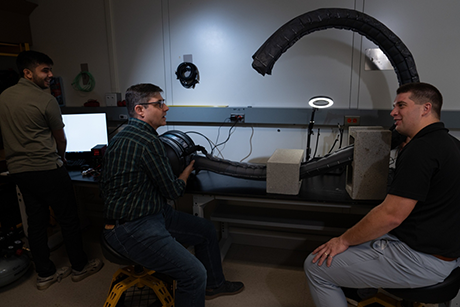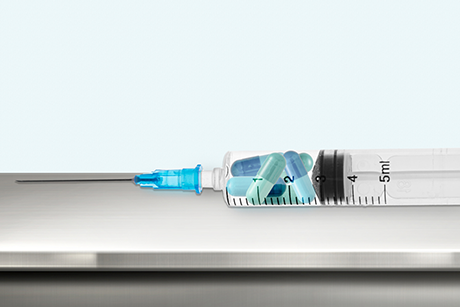Talking Shop: Professor Ian W. Hunter
The Micro Mass Spectrometer
by Alissa Mallinson

Photo credit: Tony Pulsone
Professor Ian W. Hunter sat down with us recently to discuss one of his newest inventions, a miniature (“micro”) mass spectrometer, which he developed with Dr. Brian Hemond, a former PhD student from his BioInstrumentation Lab. Earlier this year, Hunter and Hemond co-founded microMS around the handheld instrument, together producing a total of 13 separate inventions related to its fundamental technological advancements.
Where did the idea for the micro mass spectrometer come from?
Five years ago, a brilliant PhD student in our lab, Brian Hemond, started looking at all of the sub systems of one type of mass spectrometer and redesigning and combining them as a single miniature system. The result was a handheld mass spectrometer with a manufacturing cost possibly as low as $100.
A typical mass spectrometer is a large instrument for performing chemical analysis, such as determining air quality, composition of car exhaust fumes, or presence of insecticides and growth hormones on fruit or vegetables you buy. Mass spectrometers are also used extensively in forensics, engineering, materials science, biology, and chemistry. But they’re very expensive, costing anywhere from $100,000 to $1 million. And because they’re so large, samples are currently sent off to a laboratory that houses one for analysis. With our device, you bring the spectrometer to the sample as opposed to the other way around.
What does it do?
My favorite example is to imagine that you’re in a restaurant. The wine server (sommelier) brings you some wine and you swirl it around and sniff its bouquet, but actually you have our micro-mass spectrometer hidden in your pocket that analyzes its chemical compounds and displays its results on your cellphone. You could confirm that it is indeed the wine you ordered, but perhaps note that the grapes were grown on the Northern slope rather than the optimal Southern slope.
It could potentially be used for health-related reasons too. For example, when you’re shopping for fruit and vegetables, you might actually analyze the fruit and vegetables before you buy them to make sure they don’t have pesticides or insecticides on them. You could also imagine that you might have one of these in every refrigerator to detect when food is going bad. You could even cook using our micro mass spectrometer to determine how well done the meat is or if a particular sauce is ready.
Anything you can smell, this device can potentially quantify. The nose is sensitive to molecules up to a mass to charge ratio (m/z) of about 300, and this device can measure up to 350 m/z – and in a special “tuned” mode can measure up to 500 m/z.
There is also a growing interest in using mass spectrometers to try and deduce health status from your breath. There’s some evidence that certain diseases give off a chemical signature in your breath that is correlated with different disease states, so you could imagine a patient using this device at home for early detection. Of course it also brings new meaning to the breath analyzer. We make the joke that with this device, when your breath is analyzed for alcohol, you can not only estimate the alcohol content but also deduce that what you actually drank was a whiskey and two bourbons.
All of these examples enable a very important trend of empowering individuals with the ability to measure things about themselves and about their environment using personal instrumentation, as opposed to relying on an expert or sending it off and waiting a week for it to be analyzed.
How do you allow for subjectivity for more personal uses, such as identifying a great glass of wine or your favorite cup of coffee?
When you smell a flower, you probably know which smells you like and which smells you don’t. We might use the micro mass spectrometer to measure the spectra associated with those different flowers, but that’s not going to tell us which ones you like and which ones you don’t. So we plan to build a model that correlates the spectra the mass spectrometer measures with people’s subjective analysis using themselves as a measuring instrument. For example, if you were trying to quantify the smell of a wonderful fresh cup of coffee, we can measure the spectra from freshly ground coffee beans, but there’s an additional step to then correlate that to what people consider to be a marvelous aroma or a bad smell. Our plan is to create a set of aficionado user groups to build up that relationship between the chemical spectra as quantified by our micro mass spectrometer and the perceptional nature of that particular thing.
In fact, we already use ourselves as a measurement instrument, smelling food when cooking, smelling wines and cosmetics, but the difficulty is that the only way to report those interactions is to give words to the things you’re smelling to describe their qualities. But how do we know that when an individual is talking about the fine bouquet of a wine that they’re talking about the same fine bouquet of a wine that another individual is describing? This instrument will extend people’s use of themselves as a measuring instrument and augment their ability to measure things around them, from air quality or the carcinogen and lead levels in a toy, to a type of cheese or the freshness of a fruit – or even to identify what it is exactly they like about the smell of their favorite perfume. We are even enabling the idea of sharing the spectrum of a wine you like, for example, with a friend, as well as sending the data users collect back to us anonymously to identify trends and build up collective wisdom about ourselves and the world around us.
******
Hatsopoulos Professor of Mechanical Engineering Ian W. Hunter is a distinguished inventor. He has invented numerous biomedical instruments, holds several patents, and has started more than 20 companies. He received his BSc, MSc, DCP, and PhD from the University of Auckland in New Zealand, where he is an honorary professor, and has been a Professor of Mechanical Engineering at MIT since 1994. Professor Hunter’s passion for teaching has been recognized with the Keenan Award for Innovation in Undergraduate Education, the Amar Bose Award for Excellence in Teaching, and the Den Hartog Distinguished Educator Award. He is a fellow of the American Institute for Medical and Biological Engineering, and a member of the American Association for the Advancement of Science and the Institute of Electronic and Electrical Engineers. He is the director of MIT’s BioInstrumentation Lab.


